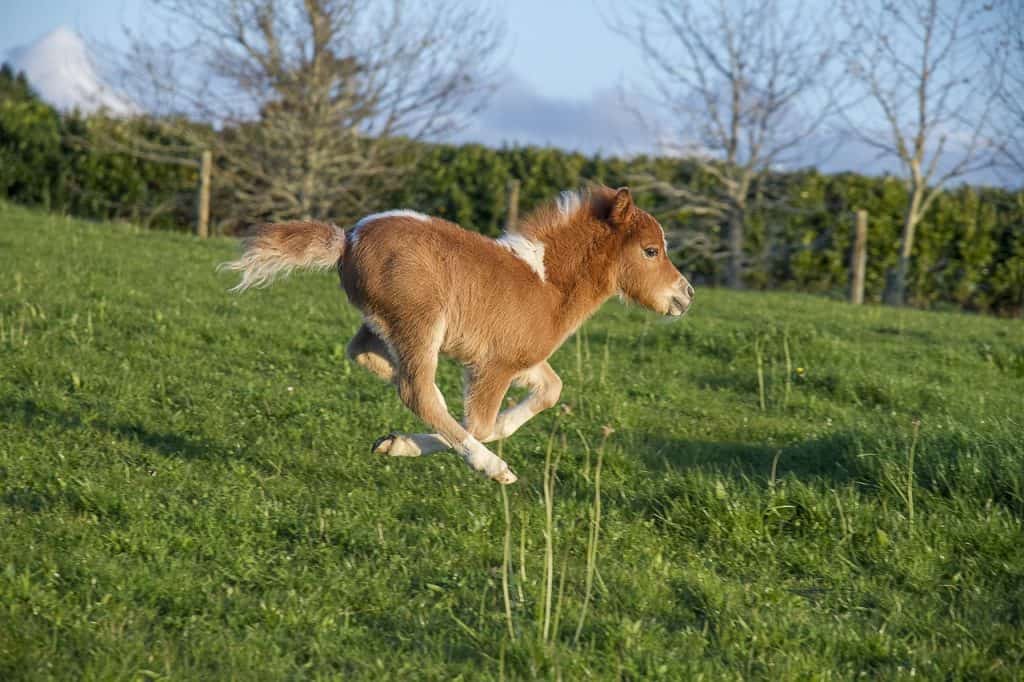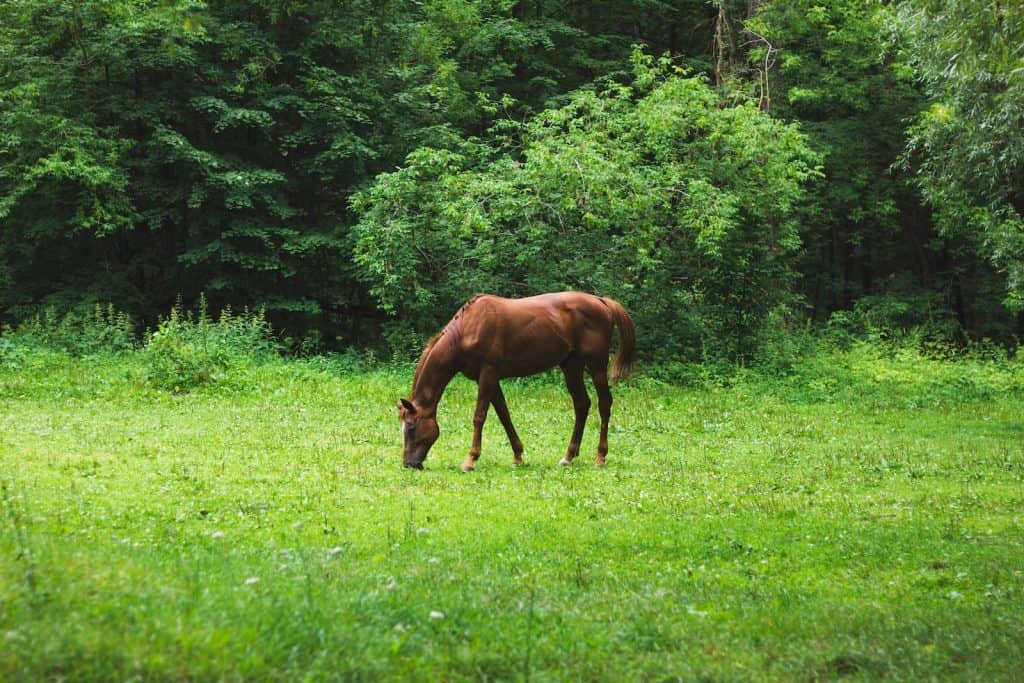
Miniature horses are great companion animals for those who don’t want to be equestrians. Although miniature horses look like their pony cousin, the Pony miniature horse is still considered a horse because they were bred to be miniature versions of full-grown horses. Ponies have short legs and thick necks. They also have fluffy manes. Miniature horses on the other side have the same refined features as larger horses.
These horses can be kept as companion animals but still need a lot of care. They do require more space and food than larger horses. This article will cover everything you need to know about these cute animals.
Here are some quick facts about the miniature horse
| Species Name: | Equus ferus caballus |
| Family: | Horse |
| Care Level | Moderate |
| Temperament: | Friendly, gentle, docile, calm |
| Color Form: | Black, bay, palomino, and chocolate |
| Lifespan: | 25-35 Years |
| Size: | 34-38 Inches |
| Diet: | Herbivorous: Hay, forage, pasture |
| Minimum Enclosure Size: | 1/2 to 1/4 acre |
| Compatibility: | Amazing |
Miniature Horse Overview
Miniature horses are not new. They have been around for centuries, having been bred from small pony and horse breeds. They were thought to have been born in Europe in 1600. Their small size allowed them to be used in jobs such as mining.

The lives of miniature horses are often longer than those of their larger counterparts. Some have even lived for over 50 years. You can find them in a wide range of colors and patterns, including solid colors as well as any type of pattern you can think of. Even though they are often ridden only by small children, they are very easy to train. They are frequently used as therapy or guide animals.
The American Miniature Horse Association states that a miniature horse must be less than 34 inches tall and around 3 feet at the withers. This is where their mane ends. Only 17.5 inches was the record for the smallest miniature horse!
What is the Average Cost of Miniature Horses?
The price of a miniature horse will vary depending on its availability and the horse’s pedigree. A miniature horse’s cost will depend on its size, conformation, breed, and show record. An adult miniature horse may be available for purchase for $300-$400. However, show-quality animals can cost between $1,000 and $200,000. This does not include initial setup fees, annual feeding, farrier, and housing costs.
The Typical Behavior and Temperament
Miniature horses make great companion pets. They are gentle, friendly, playful, social, docile, and curious. Miniature horses are intelligent and quick learners. They can also be obedient and easygoing. All miniature horses are unique and have their own quirks.

Although miniature horses may seem more horselike than most, they are much more gentle and friendly. They enjoy being around people and are open to social interaction with other animals.
Appearance and Varieties
Miniature horses are able to have a wide variety of appearances due to their mixed heritage. You can find them in any color or pattern you like, and they are approximately 150-250 pounds once fully grown. They should not exceed 34 inches in height according to the AMHA. American Miniature Horse Registry, (AMHR), recognizes two distinct divisions of miniature horses. The horses of the “A” division are approximately 34 inches in length, while the “B” division allows for larger variations (34-38 inches and up 50 pounds).
The miniature horse is either bred as a stock variety or a refined type. Stock horses look more like a pony, and have stocky bodies, broad chests, and muscular legs. The miniature horse is a more refined breed, with a shorter body and longer legs. It also has a smaller head, with a slightly wider forehead.
How to Care for Miniature Horses
Miniature horses require the same care as regular horses but on a smaller scale. Although they are easier to care for, miniature horses still require a lot of attention and dedication.

Housing basics
You will need at least one acre for your miniature horse to be able to exercise, play and forage. You will need a secure area with ample grazing and foraging areas. It will be necessary to have a larger area if there are more horses or if the space is shared by other animals.
Barn
A barn is a place for your horse to rest and grow. Mini-horse owners may keep their animals indoors as therapy or guide animals. However, for most people, a small barn is the best option. Prefabricated barns are easy to erect and can be ordered online. You can also build your own barn for a low price. The ideal stall for horses is a three-sided one. It has sufficient airflow to keep them cool and healthy, and the walls should not be too high so that your horse can see through.
Are Miniature Horses able to get along with other pets?
Miniature horses can get along with dogs, cats, horses, and livestock in general. Minis can be friends with dogs, especially if they are raised together. Cats will also become friends with minis. Minis are loved by sheep and goats to the point that they regard them as their own, and even become protective of them. Horses, donkeys, and all other minis are great companions.
It is important to be patient when introducing your miniature horse to other pets at home. These animals are usually friendly and docile but can become skittish or scared of unfamiliar animals. To avoid overwhelming boisterous dogs, keep them in the barn. They should be one happy family within a few weeks!
How to feed your miniature horse

A miniature horse can be fed in the same way as a regular horse but on a smaller scale. They should be fed grass, forage, hay, and occasionally rolled oats, or other grains, just like all horses. It’s easy for horses to become overweight due to their small stature. Follow the recommended guidelines to prevent them from becoming obese. A 200-pound horse should receive 2-4 pounds of forage daily.
A large part of their diet should come from grass and other plants. A mixture of grains is pressed into pellets for horse feed. While these can be great, make sure you choose the right mix for your horse.
Keeping Your Miniature Horse Healthy
Miniature horses can live up to three times as long as regular horses, and they have plenty of space to run, forage, and exercise. You should be aware of potential health problems such as dwarfism mutations that can cause many health complications and obesity. Miniature horses are more likely to become overweight than other animals due to a lack of exercise or excessive feeding.
Regular grooming is required for these horses, as with larger horses. This horse has less area to groom, which makes it easier. You’ll need to brush your mini horse every day. A farrier who is a specialist in mini horses will be able to take care of their hooves.
Breeding Mini Horses
While most females are only bred after they are 3 years old, some breeders brew them at 2 years. This depends on the breed. Some breeders wait up to four years to ensure that the female is fully developed and ready to give birth. Stallions, however, can be born at about 2 to 3 years of age, after their testicles have drained into their scrotum.
The average heat cycle for a mare lasts 5-7 days every 21-days, though this can vary from one female to another. If there are no complications, females usually become pregnant between 310-360 days. The foal is born quickly once labor starts, if possible, usually within 10 minutes. Most mares will foal between 10-12 months.
Are Miniature Horses suitable for you?
A miniature horse can be a great alternative to a larger horse for owners who have limited space. They are generally easier to train than larger horses, and they are more friendly than larger horses. They require the same care as mature horses and are an enormous responsibility due to their long lives. They are great companion animals for families and children and can be friendly to all.
A miniature horse is a great alternative if you love horses but don’t have enough space for a larger horse.
Is a miniature horse a suitable pet?
Miniature horses are often kind, gentle, playful, docile, sociable, and interested, making them excellent companion pets. They are renowned to be bright creatures who learn rapidly, as well as being obedient and laid-back.
How old are tiny horses?
Mini horses can live up to one-third as long as standard horses. Their typical lifespan extends from 25 to 35 years, implying that they regularly outlive their full-sized counterparts. They also consume far less food.
Are miniature horses aggressive in action?
Of course, there are instances when Miniature Horses are violent against their owners. Horses that kick, pin their ears, and bite. But there are a few things to keep in mind regardless of the kind of hostility.
Do miniature horses require shoes?
Miniatures do not normally wear shoes, but they still require regular farrier service every six to eight weeks to maintain hoof health and avoid lameness. Pick out your mini’s hooves on a regular basis to clean away pebbles and avoid thrush.
What do miniature horses require?
Every day, horses, minis, and ponies require at least 1-1.5 pounds of hay or pasture (on a dry matter basis) per 100 pounds of body weight. A 300-pound miniature horse, for example, requires at least 3-4.5 pounds of hay per day or 9-13.5 pounds of pasture (fresh grass has a considerably greater water content) every day.
Is it possible to have a miniature horse in your backyard?
The majority of owners choose a barn or shelter so that individual animals may be separated for feeding. If you only have miniatures in the pasture, the fencing can be made shorter. Because they are not dogs, they should not be kept in dog-sized places such as backyards.
What height should a miniature horse fence have?
The fencing should be around 4 feet tall. Choose pressure-treated wood poles that are smooth. Line posts should be 5 1/2 to 6 inches long and 5 inches to 7 inches square, while corner poles should be 7 inches long and 8 inches square.
What size stall does a tiny horse require?
Stall dimensions and barn opinions range, but 8 by 8 feet to 10 by 10 feet is spacious enough for a miniature horse to walk around easily while not being too huge to make them prone to drafts and cold in their individual stalls.
What is the name of a little horse?
Ponies and mini horses are both little in comparison to a standard-sized horses, yet they have distinct morphological distinctions.